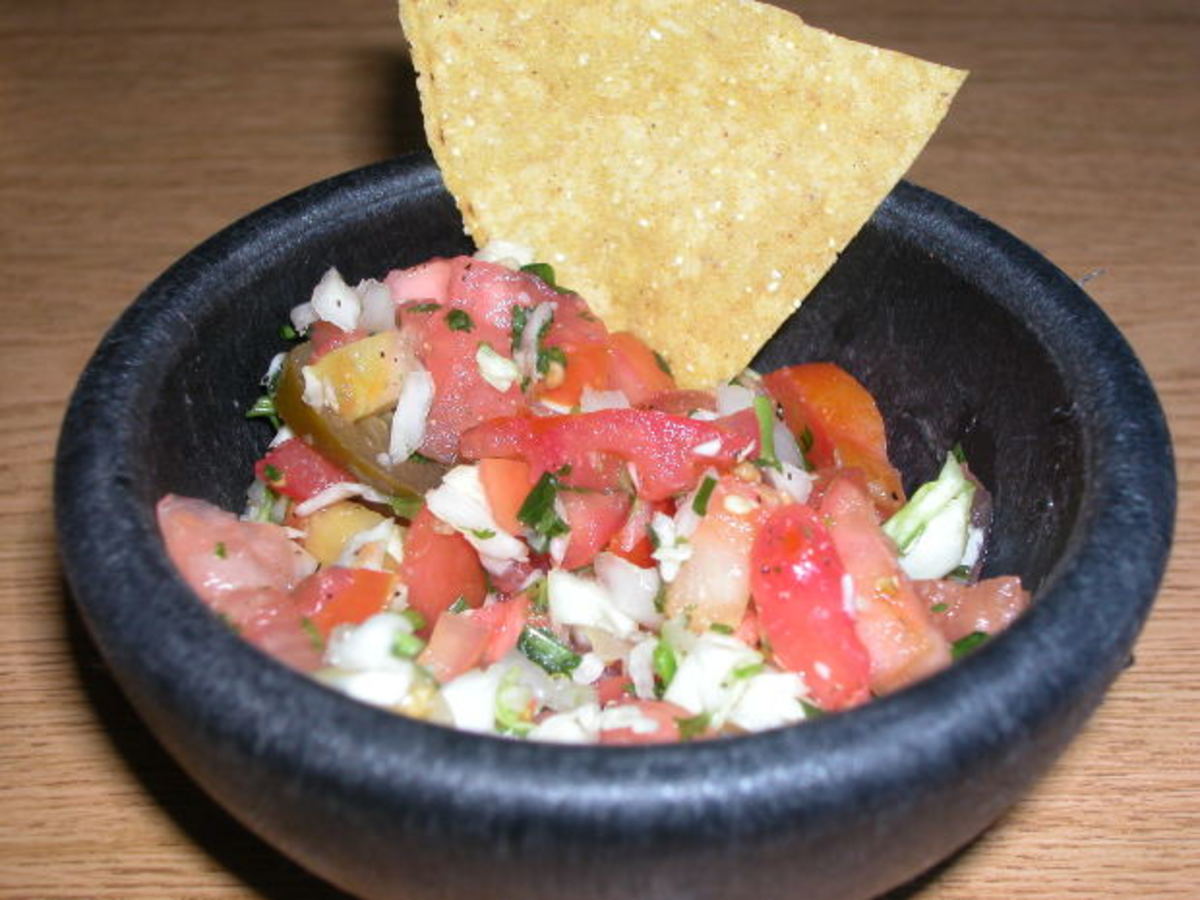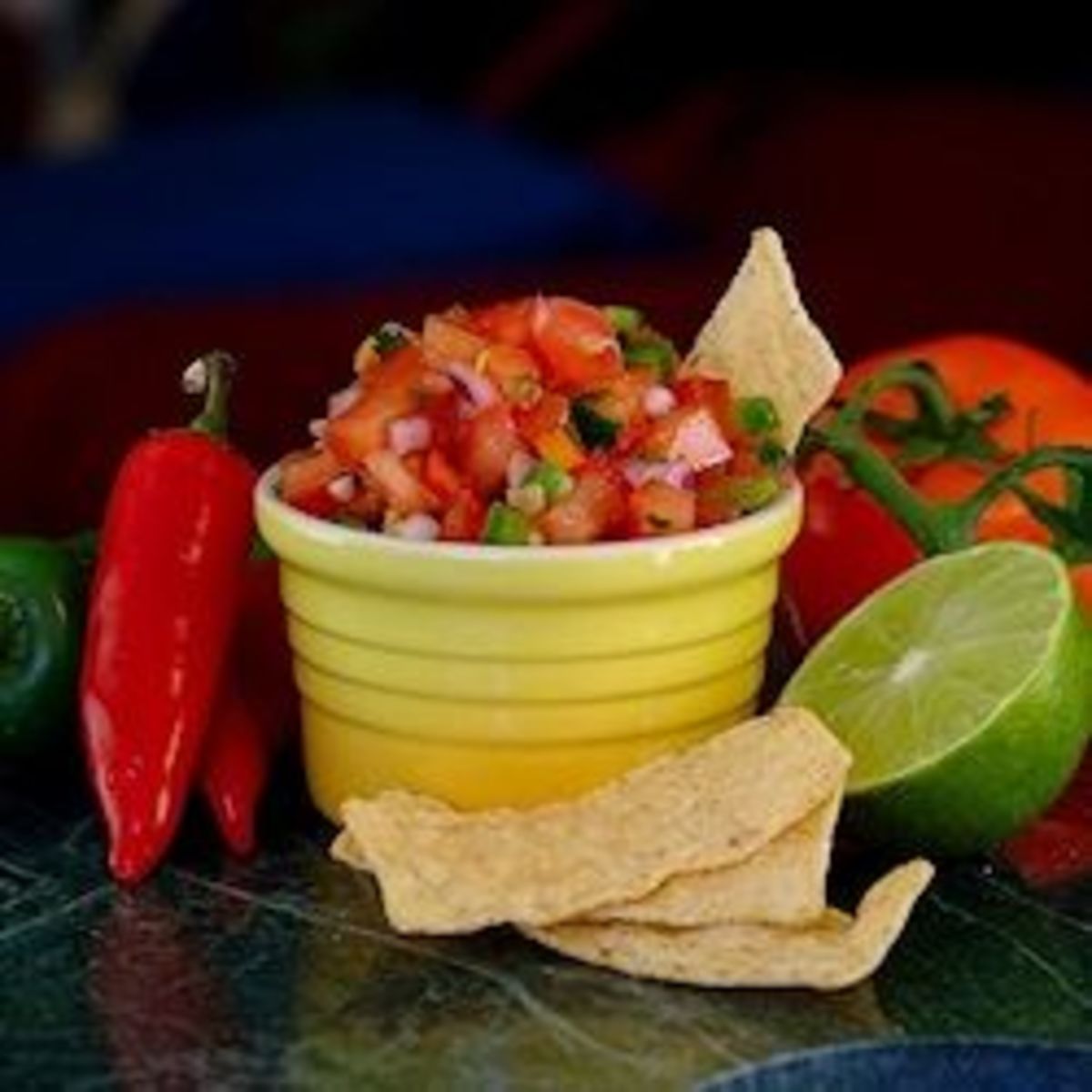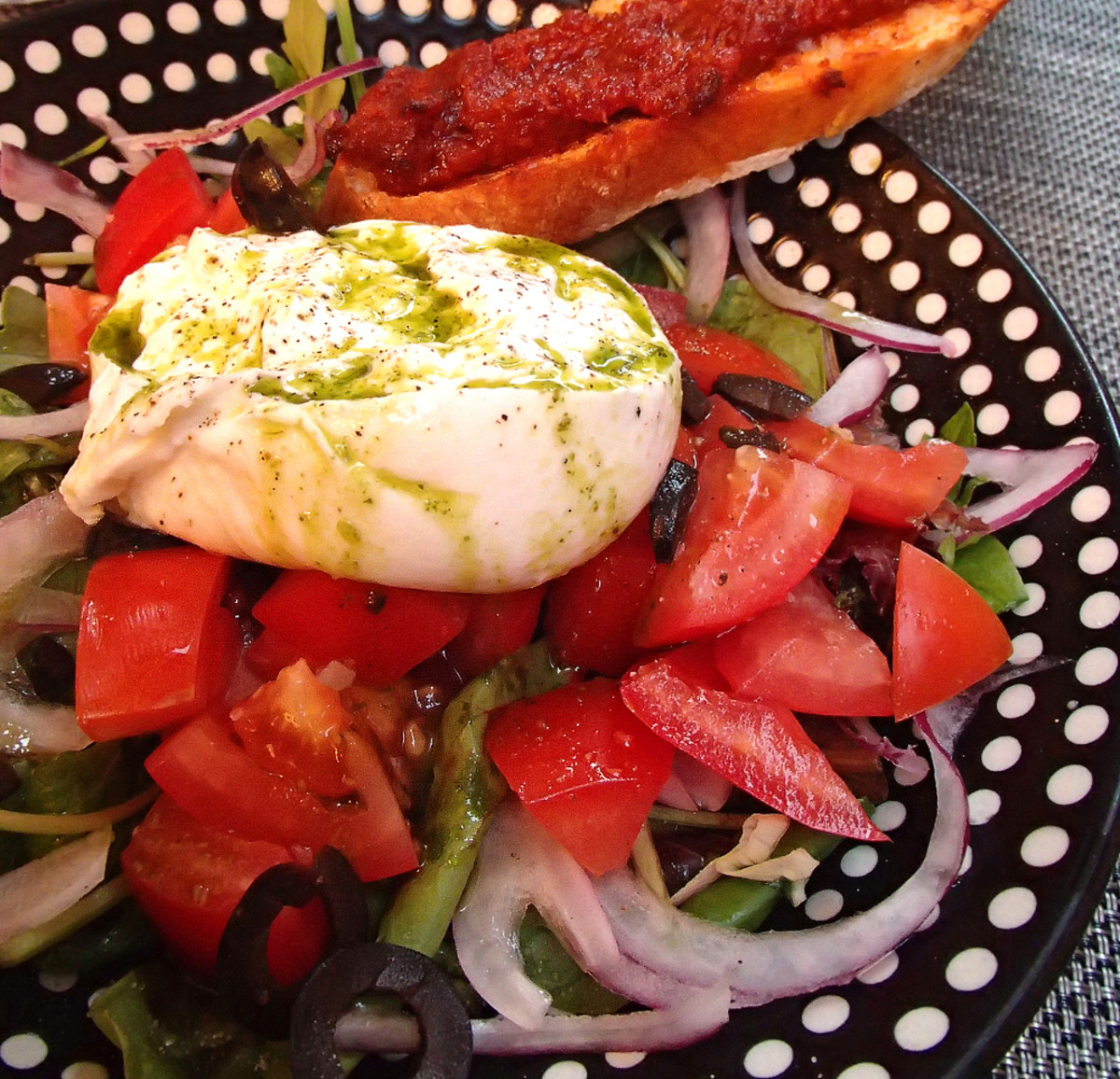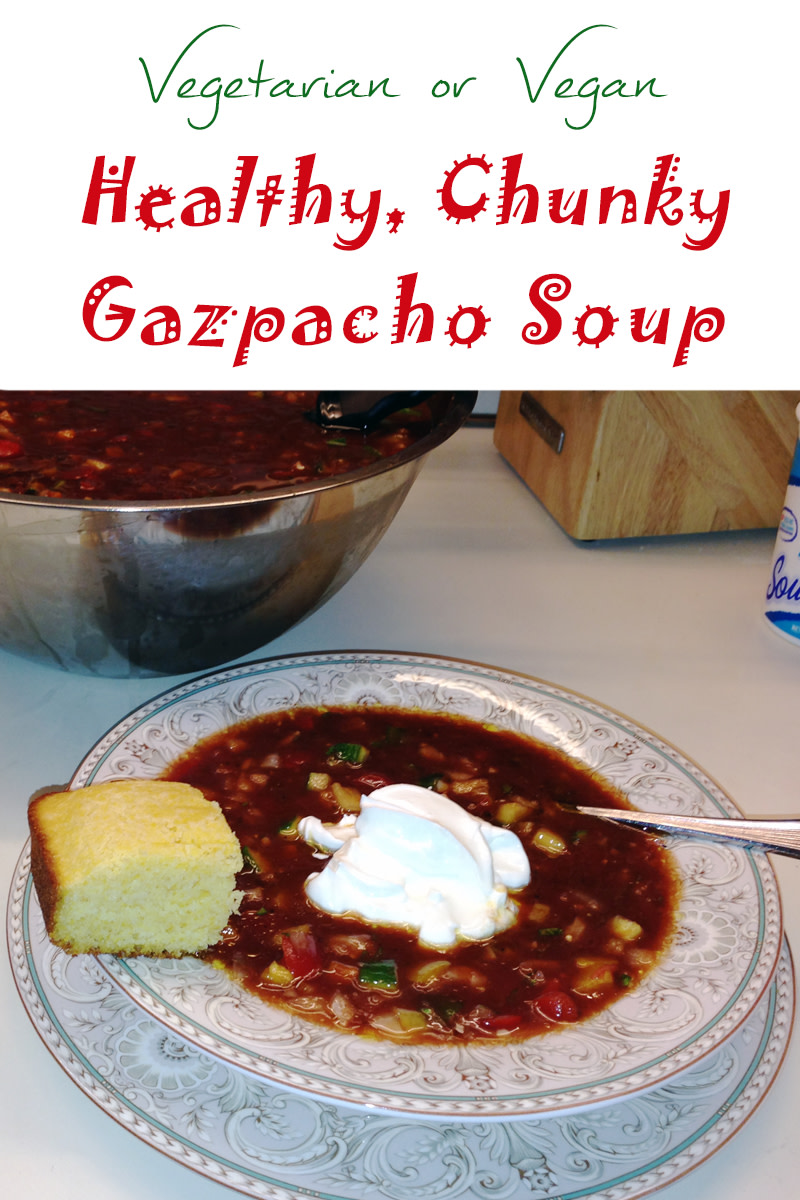Salsa Recipe - Southern Style
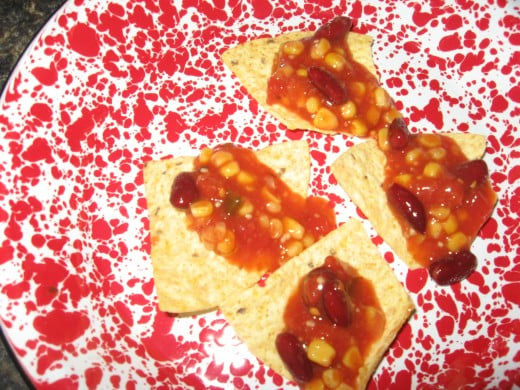
Salsa Recipes
Do you have several salsa recipes? I do, and I rarely use the exact same recipe more than once. Which salsa recipe I use at any given time depends on how I’m using it and on the ingredients I have on hand at the time. Most traditional salsa recipes use diced tomatoes as a base, but there are many other directions to go. For example, we really like fruit salsas with meats like grilled chicken and grilled pork chops. Some types are also good with grilled or blackened fish. Sometimes I might add black beans, red beans, chili beans, diced avocado, or corn to my tomato salsa recipes. I love southern food, and lots of times, if something isn't "southern," I'll make it southern! This is kind of a southern salsa recipe. I love homemade salsa, and I made a big batch of it for our GA-FL Football party yesterday, and there’s only about one tablespoon left! That’s the great thing about making salsa – there really aren’t any rules. In one of my favorite salsa dips, I add shredded cheese, and it’s wonderful with corn chips. That particular recipe also includes Catalina dressing. Yeah, I know – sounds sort of weird, doesn’t it? Whenever I serve the dip at parties, there’s never a drop left. See? You can get just as creative as you want with salsa recipes!
Mexican Salsa
We enjoy authentic Mexican salsa at least once or twice a week, made by our friends from Mexico who own a local restaurant. They make a tasty red salsa, but I absolutely love their hot and spicy salsa verde! In case you don’t know, that’s a green version that’s made from tomatillos, green chili peppers, onions, cilantro, and garlic. Traditional Mexican salsa usually includes tomatoes, onion, peppers, cilantro, lime juice, and salt. It might also include black pepper, cumin, garlic, scallions, chili powder, and/or oil.
We go through quite a bit of Mexican salsa at home. We eat it with tortilla chips, potato chips, burritos, tacos, fajitas, and taco salads. Sometimes I make my own, and sometimes we buy commercial salsas from the supermarket. Even when I use the already prepared versions, however, I usually do some tweaking by adding some of my favorite ingredients. Actually, that might be a good way for you to start experimenting with making salsa.

Homemade Salsa
No salsa is as good as homemade salsa, in my opinion. We used to grow lots of tomatoes, peppers, and onions in our very large vegetable garden, and I made gallons of homemade salsa. It was awesome! Seriously – people used to eat it straight from the jar, all by itself. It was that good. It was just the right mixture of acidic and spicy, with just a tad of sweetness. It was also a little on the hot side, as I like a combination of hot, savory, and sweet.
If you decide to make fruit salsa, be careful about the fruits you select. Firm fruits work best. These might include apples, pears, firm peaches, or pineapple. Mango makes a great addition to fruit salsas, too, but be sure to use firm mangoes. Fully ripe, soft mangoes tend to get “mushy.” Also, you might even want to consider using dried fruits. If you like, you can chop and plump the dried fruits in lime or lemon juice first. And, by the way, you can even add chopped nuts to fruit salsa. Or try adding some shredded coconut for fruit salsa with a tropical twist.
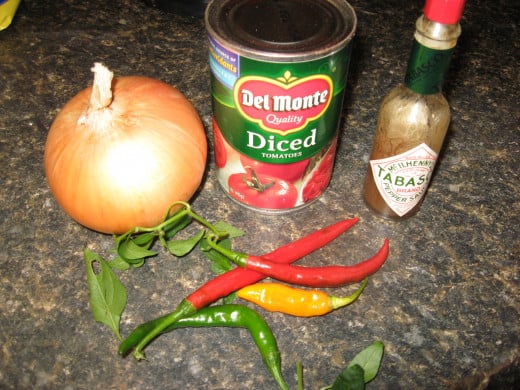
Fresh Salsa
You’ve probably heard the term fresh salsa, but do you know what it means? Most people use the term to describe salsa that’s made from garden fresh ingredients instead of canned or cooked ingredients. That often means fresh diced tomatoes as a base. In my opinion, the best salsa is a mixture of fresh ingredients and canned or cooked ingredients – especially tomatoes. Adding stewed tomatoes to salsa recipes provides a richer flavor. You get the richness of the cooked tomatoes and the brightness of fresh tomatoes.
To make fresh salsa with fruits, use fresh fruits. In a pinch, I’ve used canned pineapple a time or two, but fresh is better. Fresh herbs are better than dried, too, and use real chopped onions and peppers instead of the frozen or dehydrated type. Also, use fresh minced or chopped garlic instead of garlic powder. By using fresh ingredients, you’ll get more flavor and a better “body” and texture.
What types of peppers should you use? That depends on how much heat you want. I usually incorporate several different types of peppers in my Mexican salsa – green bell peppers, jalapeno peppers, and a small amount of Scotch bonnet peppers. For fruit salsas, I really like sweet red bell peppers and jalapenos. Like I said, I enjoy the sweet-hot combination.
Salsa Ingredients
If you’re ready to try your hand at making salsa, I have some ideas that might help get you started. Try experimenting with different flavor combinations to serve with different dishes. You might be surprised by just how much homemade salsa can add some pizzazz to otherwise boring foods! Try a few of these salsa ingredients at home.
Salsa Ingredients:
Veggies and Fruits
| Herbs and Spices
| Liquids
|
|---|---|---|
canned tomatoes
| cilantro
| lime juice
|
fresh tomatoes
| black pepper
| lemon juice
|
tomatillos
| cayenne
| orange juice
|
bell peppers
| cumin
| apple juice
|
hot peppers
| chipotle powder
| pineapple juice
|
onions
| chili powder
| olive oil
|
garlic
| mint
| hot sauce
|
apples
| oregano
| vinegar
|
mangos
| paprika
| honey
|
pineapple
| garlic salt
| tequila
|
pears
| garlic powder
| tomato sauce
|
avocados
| onion powder
| ketchup
|
How To Make Salsa
How to make salsa isn’t exactly rocket science, and there’s really no way to go wrong – unless you add too much salt or other seasonings. Once you decide on the type of salsa you want to make – Mexican salsa, green salsa, fresh salsa, or fruit salsa – you’ll need to decide whether you want chunky salsa or a smoother version. For chunky salsa, you’ll need to dice your fruit or vegetables into larger pieces. For a super smooth salsa, you might want to run the mixture through the blender or food processor to puree it.
Once you have all your fruits and/or veggies chopped or diced, add your herbs and spices. Be careful, though – don’t use so much that they overpower the basic ingredients of the salsa. Taste as you go. That’s the best way to judge the amount of herbs, spices, and other seasonings to use. Remember, however, that if you leave your homemade salsa in the refrigerator for a while, some of the flavors will become more pronounced.
Once you’ve combined your ingredients, you’ll probably want to add a little liquid to the mix to sort of “tie everything together.” For Mexican salsa, most people use lime or lemon juice for this purpose. Personally, I prefer lime juice with just a small amount of vinegar. With fruit salsas, you can get more creative. A combination of vinegar and lime juice, along with a sweeter fruit juice works well for me. I might include orange juice, tangerine juice, pineapple juice, or apple juice. Be careful with the amount of liquids you add, as you don’t want your salsa recipe to be too soupy.
Recipe For Salsa
In this recipe for salsa, I liquefied some of the canned tomatoes in the blender, but if you like an extra chunky salsa, you might want to skip that step. I find that it gives the salsa a better consistency. If you like a smoother salsa, you can chop the kidney beans up into smaller pieces. If you have frozen corn, you can use it instead of the canned corn. Just be sure to thaw and drain it well first. You might also want to adjust the heat. My salsa recipe below includes some heat. It’s not too hot for me or hubby, and my grandkids enjoyed it, too. Remember though, that these are southern kids who were reared on hot sauce!
Rate my salsa recipe. Gracias!
Cook Time
Ingredients
- 1 can diced tomatoes with green chilies, drained
- 2 Roma tomatoes, diced
- 1 can whole kernel corn, drained
- 1 can dark red kidney beans, rinsed and drained
- 1/2 large onion, chopped or diced
- 2 tablespoons chopped cilantro, (optional)
- 2 tablespoons BBQ sauce
- 1 tablespoon lime juice
- 1 tablespoon molasses
- 1 tablespoon Louisiana hot sauce
- 2 teaspoons minced garlic
- 1 teaspoon chipotle powder
- 1 teaspoon chili powder
- salt, to taste
Instructions
- Run can of diced tomatoes through the blender to liquefy.
- Pour the contents of the blender into a large bowl.
- Add remaining ingredients and stir well.
- Cover and refrigerate for several hours before using. Serve with your favorite tortilla chips.

